Differential trans-impedance amplifier
a technology of trans-impedance amplifier and differential amplifier, which is applied in differential amplifiers, amplifiers with semiconductor devices/discharge tubes, amplifier details, etc., can solve the problems of degraded gain and bandwidth performance, severe degraded performance, and photo diode biasing
- Summary
- Abstract
- Description
- Claims
- Application Information
AI Technical Summary
Benefits of technology
Problems solved by technology
Method used
Image
Examples
Embodiment Construction
[0023]While the present teachings are described in conjunction with various embodiments and examples, it is not intended that the present teachings be limited to such embodiments. On the contrary, the present teachings encompass various alternatives and equivalents, as will be appreciated by those of skill in the art.
[0024]Compared to the above described single-ended schemes, a differential TIA scheme has advantages because the differential signal becomes 2× larger, while the RMS added random noise is only √2× larger, and therefore the differential TIA has increased SNR by only √2×. Moreover, differential TIA schemes provide better linearity for large input currents and low gain settings due to better common mode rejection ratio (CMRR) by 2nd harmonics rejection. Improved linearity is critical in PAM4 or higher order modulation schemes.
[0025]With reference to FIG. 3, an optical receiver 20, in accordance with the present invention, comprises of a photodetector, e.g. photo diode (PD)...
PUM
 Login to View More
Login to View More Abstract
Description
Claims
Application Information
 Login to View More
Login to View More - R&D
- Intellectual Property
- Life Sciences
- Materials
- Tech Scout
- Unparalleled Data Quality
- Higher Quality Content
- 60% Fewer Hallucinations
Browse by: Latest US Patents, China's latest patents, Technical Efficacy Thesaurus, Application Domain, Technology Topic, Popular Technical Reports.
© 2025 PatSnap. All rights reserved.Legal|Privacy policy|Modern Slavery Act Transparency Statement|Sitemap|About US| Contact US: help@patsnap.com



